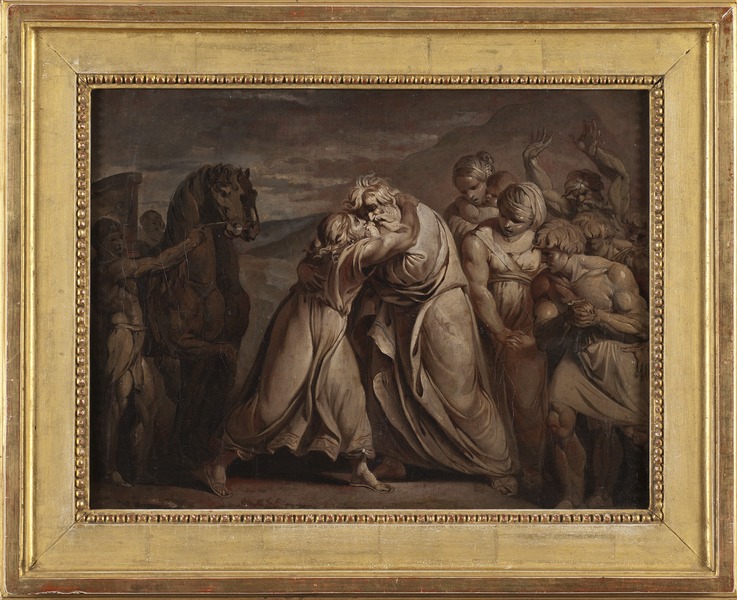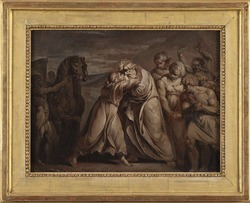File:Joseph meets his father Jacob in the desert (Jean-Antoine Julien de Parme) - Nationalmuseum - 132587.tif

Original file (3,355 × 2,730 pixels, file size: 26.24 MB, MIME type: image/tiff)
Captions
Captions
| Julien de Parme: Joseph meets his father Jacob in the desert
|
|||||||||||||||||||||||||||
|---|---|---|---|---|---|---|---|---|---|---|---|---|---|---|---|---|---|---|---|---|---|---|---|---|---|---|---|
| Artist | |||||||||||||||||||||||||||
| Title |
English: Joseph meets his father Jacob in the desert Svenska: Josef träffar sin far Jakob i öknen, vid portarna till Egypten |
||||||||||||||||||||||||||
| Object type |
painting object_type QS:P31,Q3305213 |
||||||||||||||||||||||||||
| Genre |
religious art |
||||||||||||||||||||||||||
| Description |
English: Julien de Parme was of Swiss origin, but worked in Italy and France. In this work, he has used oil paint to try to emulate the plasticity of a sculptural relief. The painting is a typical example of the deep impact that antique sculpture had on artists in the late 18th century. This painting belonged to the Swedish sculptor Johan Tobias Sergel, who lived in Rome in the 1770s, at the same time as Julien de Parme. Svenska: Julien de Parme var av schweiziskt ursprung, men verksam i Italien och Frankrike. I det här verket har han med oljemålningen som medium försökt efterlikna plasticiteten i en skulpturrelief. Målningen är ett tydligt exempel på den antika skulpturkonstens stora betydelse för konstnärerna under slutet av 1700-talet. Målningen har tillhört den svenske skulptören Johan Tobias Sergel, som på 1770-talet vistades i Rom samtidigt som Julien de Parme. |
||||||||||||||||||||||||||
| Original caption InfoField | English: Julien de Parme was of Swiss origin, but worked in Italy and France. In this work, he has used oil paint to try to emulate the plasticity of a sculptural relief. The painting is a typical example of the deep impact that antique sculpture had on artists in the late 18th century. This painting belonged to the Swedish sculptor Johan Tobias Sergel, who lived in Rome in the 1770s, at the same time as Julien de Parme. Svenska: Julien de Parme var av schweiziskt ursprung, men verksam i Italien och Frankrike. I det här verket har han med oljemålningen som medium försökt efterlikna plasticiteten i en skulpturrelief. Målningen är ett tydligt exempel på den antika skulpturkonstens stora betydelse för konstnärerna under slutet av 1700-talet. Målningen har tillhört den svenske skulptören Johan Tobias Sergel, som på 1770-talet vistades i Rom samtidigt som Julien de Parme. |
||||||||||||||||||||||||||
| Date |
Unknown date Unknown date |
||||||||||||||||||||||||||
| Medium |
oil on canvas medium QS:P186,Q296955;P186,Q12321255,P518,Q861259 |
||||||||||||||||||||||||||
| Dimensions |
|
||||||||||||||||||||||||||
| Collection |
institution QS:P195,Q842858 |
||||||||||||||||||||||||||
| Accession number |
NM 7073 |
||||||||||||||||||||||||||
| Inscriptions |
Svenska: Påskrift: Herr Särgell [i rödkrita, a tergo, på ramen]
Påskrift: "Särgell [i blyerts, a tergo, på ramen] Påklistrad lapp: "B 6" samt fragment av en ytterligare papperslapp med påskrift (oläsl.) |
||||||||||||||||||||||||||
| References | |||||||||||||||||||||||||||
| Source/Photographer | Per-Åke Persson / Nationalmuseum | ||||||||||||||||||||||||||
| Permission (Reusing this file) |
|
||||||||||||||||||||||||||
File history
Click on a date/time to view the file as it appeared at that time.
| Date/Time | Thumbnail | Dimensions | User | Comment | |
|---|---|---|---|---|---|
| current | 00:53, 8 October 2016 |  | 3,355 × 2,730 (26.24 MB) | AndreCostaWMSE-bot (talk | contribs) | {{Artwork |other_fields_1 = |artist = Jean-Antoine Julien de Parme |title = {{en|Joseph meets his father Jacob in the desert}} {{sv|Josef träffar sin far Jakob i öknen, vid portarna till Egypten}... |
You cannot overwrite this file.
File usage on Commons
The following 3 pages use this file:
File usage on other wikis
The following other wikis use this file:
- Usage on en.wikipedia.org
- Usage on fr.wikipedia.org
- Usage on sv.wikipedia.org
- Usage on www.wikidata.org
Metadata
This file contains additional information such as Exif metadata which may have been added by the digital camera, scanner, or software program used to create or digitize it. If the file has been modified from its original state, some details such as the timestamp may not fully reflect those of the original file. The timestamp is only as accurate as the clock in the camera, and it may be completely wrong.
| Image title | Jean-Antoine Julien, called Julien de Parme:
Joseph meeting his father Jacob in the desert, at the frontier of Egypt . NM7073 |
|---|---|
| Camera manufacturer | NIKON CORPORATION |
| Camera model | NIKON D2X |
| Exposure time | 1/100 sec (0.01) |
| F-number | f/6.3 |
| ISO speed rating | 100 |
| Date and time of data generation | 14:41, 19 July 2011 |
| Lens focal length | 60 mm |
| Width | 3,355 px |
| Height | 2,730 px |
| Bits per component |
|
| Compression scheme | Uncompressed |
| Pixel composition | RGB |
| Image data location | 34,222 |
| Orientation | Normal |
| Number of components | 3 |
| Number of rows per strip | 2,730 |
| Bytes per compressed strip | 27,477,450 |
| Horizontal resolution | 300 dpi |
| Vertical resolution | 300 dpi |
| Data arrangement | chunky format |
| Software used | Adobe Photoshop CS5 Windows |
| File change date and time | 10:46, 21 July 2011 |
| Exposure Program | Manual |
| Exif version | 2.21 |
| Date and time of digitizing | 14:41, 19 July 2011 |
| APEX shutter speed | 6.643856 |
| APEX aperture | 5.310704 |
| APEX exposure bias | 0 |
| Maximum land aperture | 3 APEX (f/2.83) |
| Subject distance | 2 meters |
| Metering mode | Spot |
| Light source | Flash |
| Flash | Flash did not fire |
| DateTime subseconds | 08 |
| DateTimeOriginal subseconds | 08 |
| DateTimeDigitized subseconds | 08 |
| Color space | Uncalibrated |
| Sensing method | One-chip color area sensor |
| File source | Digital still camera |
| Scene type | A directly photographed image |
| Custom image processing | Normal process |
| Exposure mode | Manual exposure |
| White balance | Manual white balance |
| Digital zoom ratio | 1 |
| Focal length in 35 mm film | 90 mm |
| Scene capture type | Standard |
| Scene control | None |
| Contrast | Soft |
| Saturation | Normal |
| Sharpness | Soft |
| Subject distance range | Unknown |
- Unknown date
- Content made available through Wikimedia Sverige partnerships
- CC-PD-Mark
- PD-old-100
- Images from the Nationalmuseum Stockholm
- PD-Art (PD-old-auto)
- Licensed-PD-Art missing SDC copyright license
- Artworks with known accession number
- Artworks with Wikidata item
- Artworks with Wikidata item missing date
- Artworks digital representation of 2D work
- Media contributed by Nationalmuseum Stockholm: 2016-10




